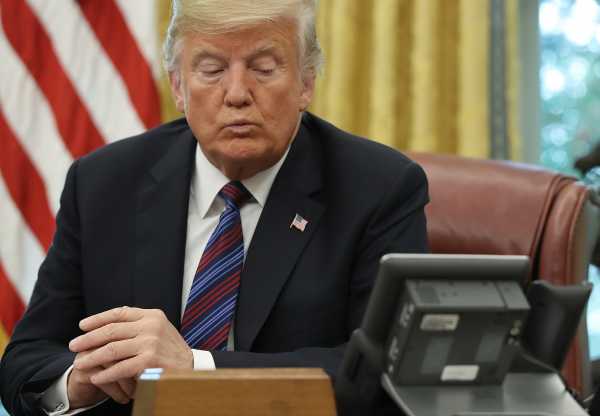
You’re going to be getting an emergency alert from President Donald Trump on your phone on Wednesday afternoon. It’s a test of a new alert system that’s supposed to be used in very specific circumstances to communicate with the public via cell phones — and that experts say won’t let presidents just text the American public at will.
At 2:18 pm Eastern Time Wednesday, FEMA and the FCC will do their first test of the Wireless Emergency Alerts system. More than 100 mobile carriers, including all major wireless companies, are participating. A second test that will put messages on TV and radio, known as the Emergency Alert System, will take place a couple of minutes later.
The wireless test message will read “Presidential Alert” and include a clear warning that it’s just a test, per FEMA: “THIS IS A TEST of the National Wireless Emergency Alert System. No action is needed.” It will be transmitted in both English and Spanish. Cell towers will broadcast the test for about a half an hour, during which time most cellphones that are switched on and within range of an active cell tower will get the test message.
The TV and radio system has been tested three times before; the texting system hasn’t. The test was initially scheduled for September but was postponed because of Hurricane Florence.
The system is the same one that’s used to warn the public about dangerous weather or missing children, such as tornado warnings and Amber Alerts. Users can’t opt out of texts, a requirement from a 2006 law passed by Congress called the Warning, Alert, and Response Network Act. Congress requires the system be tested every three years.
The idea of Trump having control over a nationwide wireless alert system may seem unsettling or annoying, given that most Americans think the president tweets way too much. But the national warning system predates Trump and has been under development for years, and officials say there are some pretty specific guardrails in place to make sure it’s always used correctly.
“You would not have a situation where any sitting president would just wake up one morning and attempt to send a person a message,” FEMA official Antwane Johnson said on a call with reporters this week, according to Axios. “The system is very well-governed and rooted in law in terms of its intended use.”
This is (probably) fine
Given the president’s erratic tweeting habits and penchant for reacting to emergency situations without having all the facts, the idea of Trump having the ability to send alerts to the entire country could be, for some, a bit disconcerting. But the system is intended to be used for actual emergencies only — not a reaction to a Fox News segment or a declaration that the Russia investigation is a witch hunt.
According to the Integrated Public Alert and Warning System Modernization Act of 2015, the system “shall not be used to transmit a message that does not relate to a natural disaster, act of terrorism, or other man-made disaster or threat to public safety.”
“One thing that we need make very clear is that there are laws, policies, and procedures that are in place, other protocols to assure that the system is used in accordance with its intended use as defined by the law,” Johnson, from FEMA, told CBS This Morning.
Irwin Redlener, director of the National Center for Disaster Preparedness at Columbia University, told me recently that the wireless alert system is a good idea, as is testing it — but having someone as volatile as Trump with control over it is concerning.
“I’m not sure that the system would protect us from rogue announcements by a president who has exhibited the kind of behavior President Trump has over the last two years,” Redlener said. “I personally would not give this microphone to Donald Trump.”
Former Homeland Security Secretary Jeh Johnson told CBS that the system “should not be used for a political agenda.”
“If it wasn’t for the style, personality, and behavior of Donald Trump, I don’t think this question would have ever come up,” Redlener said. “Of course the president would have access [to the emergency alert system] in the situation of a national emergency.”
Emergency alert systems aren’t infallible. A false alert about an impending missile threat to Hawaii caused widespread panic in January. But the concern is more Trump’s personality than it is the accidental push of a button.
“We need to accept the fact that any of these systems can fail; miscommunications can go out when the wrong button’s being pushed. That’s a given for any system of this type,” Redlener said. “What I’m more concerned about is the president of the United States taking control over such a system intentionally to create havoc, to make some sort of highly disruptive, highly political announcement.”
Hopefully, that won’t happen.
Sourse: vox.com






